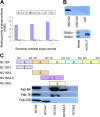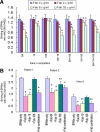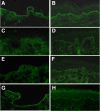Blockade of autoantibody-initiated tissue damage by using recombinant fab antibody fragments against pathogenic autoantigen
- PMID: 20042683
- PMCID: PMC2808096
- DOI: 10.2353/ajpath.2010.090744
Blockade of autoantibody-initiated tissue damage by using recombinant fab antibody fragments against pathogenic autoantigen
Abstract
Activation of the complement cascade via the classical pathway is required for the development of tissue injury in many autoantibody-mediated diseases. It therefore makes sense to block the pathological action of autoantibodies by preventing complement activation through inhibition of autoantibody binding to the corresponding pathogenic autoantigen using targeted Fab antibody fragments. To achieve this, we use bullous pemphigoid (BP) as an example of a typical autoimmune disease. Recombinant Fabs against the non-collagenous 16th-A domain of type XVII collagen, the main pathogenic epitope for autoantibodies in BP, were generated from antibody repertoires of BP patients by phage display. Two Fabs, Fab-B4 and Fab-19, showed marked ability to inhibit the binding of BP autoantibodies and subsequent complement activation in vitro. In the in vivo experiments using type XVII collagen humanized BP model mice, these Fabs protected mice against BP autoantibody-induced blistering disease. Thus, the blocking of pathogenic epitopes using engineered Fabs appears to demonstrate efficacy and may lead to disease-specific treatments for antibody-mediated autoimmune diseases.
Figures







Similar articles
-
Anti-collagen XVII single-chain Fv antibody blocks the autoimmune reaction mediated by pathogenic autoantibodies in bullous pemphigoid.J Dermatol Sci. 2013 Oct;72(1):25-31. doi: 10.1016/j.jdermsci.2013.05.010. Epub 2013 Jun 13. J Dermatol Sci. 2013. PMID: 23827201
-
Antibodies to pathogenic epitopes on type XVII collagen cause skin fragility in a complement-dependent and -independent manner.J Immunol. 2012 Jun 1;188(11):5792-9. doi: 10.4049/jimmunol.1003402. Epub 2012 Apr 20. J Immunol. 2012. PMID: 22523387
-
Bullous pemphigoid autoantibodies directly induce blister formation without complement activation.J Immunol. 2014 Nov 1;193(9):4415-28. doi: 10.4049/jimmunol.1400095. Epub 2014 Sep 26. J Immunol. 2014. PMID: 25261486
-
Update on the pathogenesis of bullous pemphigoid: an autoantibody-mediated blistering disease targeting collagen XVII.J Dermatol Sci. 2014 Mar;73(3):179-86. doi: 10.1016/j.jdermsci.2013.12.001. Epub 2013 Dec 27. J Dermatol Sci. 2014. PMID: 24434029 Review.
-
The Autoimmune Skin Disease Bullous Pemphigoid: The Role of Mast Cells in Autoantibody-Induced Tissue Injury.Front Immunol. 2018 Mar 1;9:407. doi: 10.3389/fimmu.2018.00407. eCollection 2018. Front Immunol. 2018. PMID: 29545809 Free PMC article. Review.
Cited by
-
Decreased expression levels of complement regulator CD55 contribute to the development of bullous pemphigoid.Oncotarget. 2017 Sep 23;9(85):35517-35527. doi: 10.18632/oncotarget.21216. eCollection 2018 Oct 30. Oncotarget. 2017. PMID: 30473747 Free PMC article.
-
Pemphigus and Pemphigoid: From Disease Mechanisms to Druggable Pathways.J Invest Dermatol. 2022 Mar;142(3 Pt B):907-914. doi: 10.1016/j.jid.2021.04.040. Epub 2021 Oct 29. J Invest Dermatol. 2022. PMID: 34756581 Free PMC article. Review.
-
Rituximab therapy in pemphigus and other autoantibody-mediated diseases.F1000Res. 2017 Jan 27;6:83. doi: 10.12688/f1000research.9476.1. eCollection 2017. F1000Res. 2017. PMID: 28184292 Free PMC article. Review.
-
Bullous pemphigoid IgG induces BP180 internalization via a macropinocytic pathway.Am J Pathol. 2013 Mar;182(3):828-40. doi: 10.1016/j.ajpath.2012.11.029. Epub 2013 Jan 19. Am J Pathol. 2013. PMID: 23337823 Free PMC article.
-
Mechanisms of Disease: Pemphigus and Bullous Pemphigoid.Annu Rev Pathol. 2016 May 23;11:175-97. doi: 10.1146/annurev-pathol-012615-044313. Epub 2016 Feb 22. Annu Rev Pathol. 2016. PMID: 26907530 Free PMC article. Review.
References
-
- Jacobson DL, Gange SJ, Rose NR, Graham NM. Epidemiology and estimated population burden of selected autoimmune diseases in the United States. Clin Immunol Immunopathol. 1997;84:223–243. - PubMed
-
- Holers VM. The complement system as a therapeutic target in autoimmunity. Clin Immunol. 2003;107:140–151. - PubMed
-
- Nishie W, Sawamura D, Goto M, Ito K, Shibaki A, McMillan JR, Sakai K, Nakamura H, Olasz E, Yancey KB, Akiyama M, Shimizu H. Humanization of autoantigen. Nat Med. 2007;13:378–383. - PubMed
-
- Mewar D, Wilson AG. Autoantibodies in rheumatoid arthritis: a review. Biomed Pharmacother. 2006;60:648–655. - PubMed
Publication types
MeSH terms
Substances
LinkOut - more resources
Full Text Sources
Other Literature Sources
Medical

